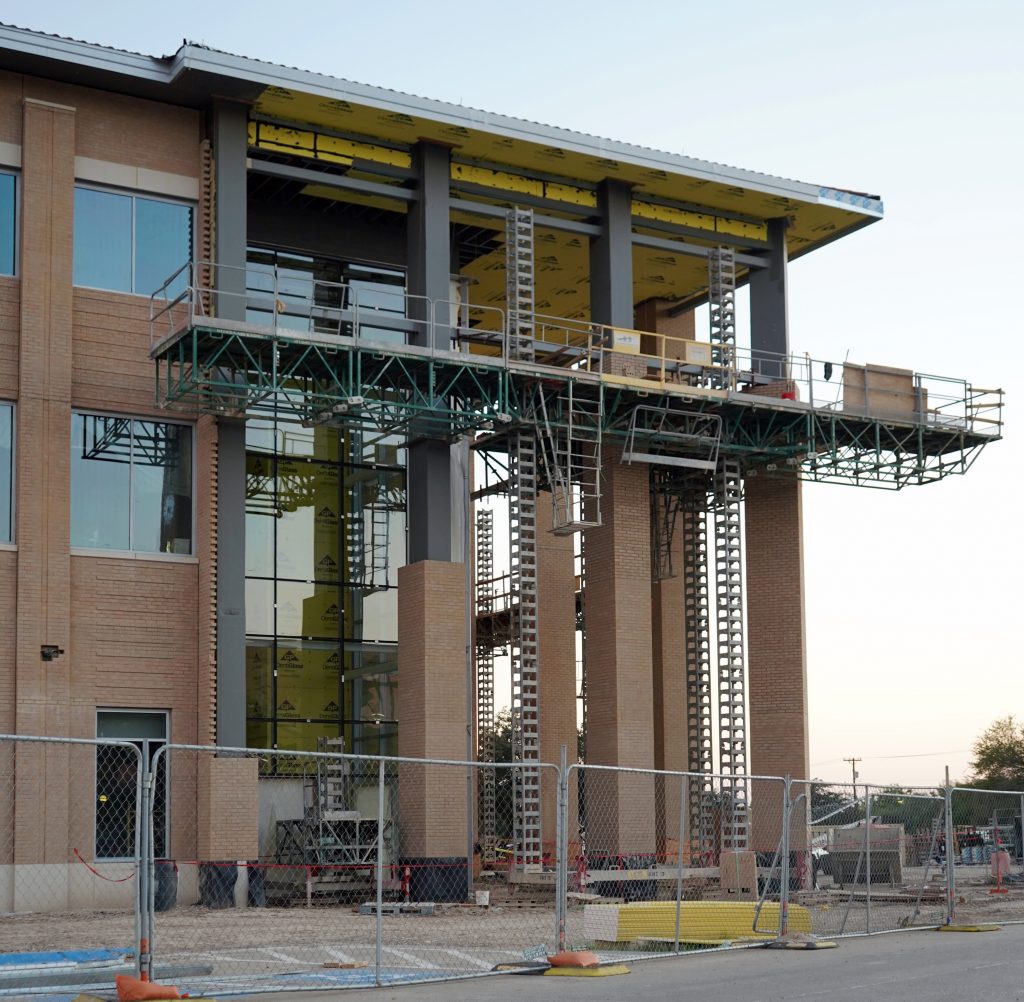NEWS: New building, expansion move toward completion
By Juan Miguel Martinez
Bridge Contributing Writer
Published Thursday, Oct. 9, 2025
Approaching an expected completion date of Spring 2026, TAMIU’s current building construction phase is nearly at an end. The new infrastructure for the 300-acre campus includes the Health Sciences Education and Research Center and an expansion to the Western Hemispheric Trade Center.
Formally announced during an April 5, 2024, groundbreaking with a total two-project budget of $71.2 million, partially funded through the Capital Construction Assistance Project, construction has continued for the past year or so on both Texas A&M International University buildings. Associate Vice President for Finance and Administration Trevor Liddle said the completion of the 57,000-gross-square-foot HSERC would allow two new degree programs to flourish at TAMIU: Medical lab sciences and a doctorate in physical therapy.

TAMIU construction continues on the new Health Sciences Education and Research Center on Sept. 30, 2025.
Liddle also said new spaces are planned for the kinesiology program for both students and faculty to conduct research.
The HSERC is also expected to house the communication disorders clinic teachers or clinician training to see patients as part of a community outreach; its focus is set on “health sciences other than nursing.” Along that main study, the HSERC expects to offer a public outreach mission to treat community members, focusing on children.
Liddle said the HSERC plans include offering programs in medical lab sciences, kinesiology, physical therapy and communication disorders.
Junior health science major Jackie Santos expects the HSERC to improve her chosen degree path by opening up opportunities for health sciences research.
Alongside study, Liddle said the HSERC plans include classrooms and labs that focus around kinesiology.
“Part of TAMIU’s experience, and part of our success is, as a general rule, [that] classrooms are not discipline specific,” Liddle said. “Now, labs are more discipline specific.”
Liddle said the 25,200-gross-foot WHTC expansion focuses around business since it’s home to the A.R. Sanchez Jr. School of Business and expects to bring back two business programs originally housed in the Sue & Radcliffe Killam Library. Those programs include the Texas Center for Border Economic and Enterprise Development and the Small Business Development Center.
These programs allow students business-ecosystem opportunities and their new home in the WHTC is expected to become the first building with a dedicated makerspace, Liddle said. Makerspaces are collaborative work spaces inside a school, library or separate public/private facility for making, learning, exploring and sharing.
The makerspace is also expected to be used by up-and-coming entrepreneurs to work on entrepreneurial-type projects with access to tools like 3D printing, potentially sewing machines, further learning how to market and other hands-on business processes besides accounting and spreadsheets.
Sophomore business marketing major Andrew Garcia said he looks forward to the WHTC expansion and expects to have more classes available and expects those classes to be held in the extension.
Liddle also said he expects most students to see the new buildings as a “hands-on experience” for the students and the community.
“[The] communication disorders [program] reaches out into the community to treat young students or young children with a communication disorder,” Liddle said. “The Small Business Development Center reaches out into the community to help people who have an entrepreneurial idea, take it from idea to reality.”
Liddle also said the building plans include “AIC-inspired seating areas.” These are large, open classrooms like those in the AIC, which can be used for seminars or informal spaces for students to meet and congregate.
On the topic of the buildings’ progress, Liddle said both buildings are on-time and on-budget.
Garcia also said he is open to surprises and looks forward to the WHTC expansion and the HSERC, while Santos said she is excited to explore the new buildings and have more classrooms to work in.
Liddle said there are also a number of proposed projects, but they require a lot of funding. He added that one question his office often hears is: “What is the building of the future?”
“We are looking into the future while we are finishing up these buildings, which are going to be beautiful additions to our campus, but we are already looking to what is possible in the future to help our degree programs,” Liddle said. “To help our research programs, but all for the benefits of the students and the [residents] of South Texas.”
